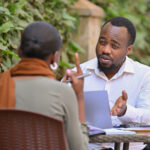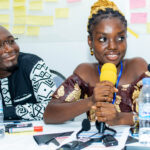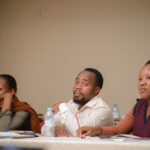This article was published more than 4 years ago.
The lights go down and the crowd roars. Kiran Deshmukh, heavy-set woman dressed in a sari, steps up to a microphone in the center of the stage.
Kiran is an aspiring stand-up comic on a tour across Maharashtra State organized by the popular Marathi-language digital platform BhaDiPa, the media and arts collective Maraa , and the Fund for Global Human Rights. But back home in the city of Sangli, she’s a sex worker.
“I’m not someone who laughs a lot,” she says.
Stand-up comedy is one of the most popular forms of entertainment in India today. It allows people to speak freely about taboo issues like race, caste, sex, or social and political change. Since 2018, the Fund has supported stand-up comedians across the country as a way to amplify marginalized voices, reach new audiences, and build broader public support for human rights.
“Stand up as an art form is a place for dissent,” says Nihaal Passanha, the organizer of Maraa. “There’s a culture of resistance that’s built into it. It’s come from a bottom-up space—people using humor to throw darts.”
But India’s comedy scene is mainly limited to major cities and features few women and rural or semi-rural voices. “Stand-up comedy venues are still concentrated in urban areas, in bars. The geography of these places restricts access. Naturally, there is a lack of representation,” says BhaDiPa co-founder Sarang Sathaye. “To reach every nook and cranny, to further reach the grassroots and to help tell stories from that soil, we must expand into regional languages.”
When BhaDiPa, Maraa, and Fund discovered a booming Marathi stand-up scene in Maharashtra, they saw an incredible opportunity to bring comedy—and a message of social development—to new audiences. Working together, they organized a series of four variety shows featuring local folk forms as well as stand-up comedians.
At each variety show, the organizers aired a short video calling for aspiring comics to submit clips of their work. “Now it is your time to speak,” the video declared. “Doesn’t matter who you are—farmers, sex workers, laborers. If you want to speak truth to power, now is the time to do it.”
“I had never done comedy before, and I was a little scared,” says Vishal Narmalwar, an aspiring stand-up comic and social activist from Chargaon, a village of fewer than 1,000 people. But at the urging of friends and family, he sent in an application.
“When I found out I had been selected,” says Vishal, “the sky felt like it was within my grasp. I was going to Mumbai!”
BhaDiPa and Maraa selected sixteen comedians from across Maharashtra, drawing on different backgrounds and cultures. They traveled to the towering metropolis of Mumbai for a four-day workshop with mentors from BhaDiPa and Maraa.
But when the workshop ended, “the participants really didn’t have access to an open mic world,” says BhaDiPi co-founder Paula McGlynn. “Most of them had to go back to really small towns and cities where nobody did stand-up comedy.”
So BhaDiPa launched a new tour—Kay Boltay, or Say What. Sixteen shows across Maharashtra gave the aspiring comics an opportunity to perform in front of new and diverse audiences. From Pune to Chandrapur, the comedians spoke about child marriages, sex, and everything in between, finding the humor in the facts of their own lives and sharing it with the audience.
The response from audiences has been overwhelmingly positive. “This channel of exploring social issues through stand-up is perfect,” says one attendee at the show in Nashik. In Sangamner, another audience member agreed that, along with laughs, the shows carried an important message of social development.
“Not many people even know that there are so many good stand-up comedians in Marathi,” says Seema Nair, the Fund’s consultant in India. “With this Kay Boltay project, we’ve not just established that Marathi comedy is possible, we’ve also established that people from diverse backgrounds can be as effective, as funny, and as brilliant in their storytelling. I think that’s just a matter of really giving them the space, the confidence, and the tools and techniques.”
By passing the microphone to under-represented and grassroots voices, the Fund hopes to plant the seed of a fairer, more inclusive future for India. Help us spread the word by watching and sharing this video.


